Market Trends of Aerostat Systems Industry
Military and Law Enforcement Segment to Dominate Market Share During the Forecast Period
The military and law enforcement segment accounted for a major market share, primarily due to increased demand for aerostat systems to support intelligence, surveillance, and reconnaissance missions and enhance network communications capabilities in land and sea platforms. Ground-based and shipboard aerostats are effective and affordable systems that offer continuous, wide-area surveillance and timely provision of target information. They may be used for applications including early intrusion alerts, illegal immigration monitoring, anti-terrorism, fishing activity surveillance, and smuggling deterrence.
Several military and law enforcement end users are considering procuring various monitoring options in the coming years. Aerostat systems are expected to be one of the viable options for procurement due to their advantage in obtaining highly accurate and real-time surveillance data at a remarkably low total cost of ownership. Furthermore, the ease of integrating advanced ISR payloads, such as electro-optical/infrared cameras, radar, and communications relays, is expected to support their procurement plans.
In March 2022, the Israeli defense ministry's missile defense organization (IMDO) delivered the Tal Shamaim High Availability Aerostat System (HAAS) to boost the Israeli Air Force's missile defense capabilities. The aerostat is one of the largest global aerostats, designed to carry an improved sensing system to provide detection and early warning of cruise missiles and advanced threats aimed at Israel. Such deployments are expected to bolster the prospects of the military and law enforcement segment in the future.

North America is Expected to Dominate the Market During the Forecast Period
The US is focused on using aerostats along the borders for surveillance and investing in developing and procuring these surveillance systems. For instance, in June 2022, the US Customs and Border Protection's (CBP) Program Management Office Directorate (PMOD) installed a 22-meter Persistent Ground Surveillance System Aerostat in Nogales, Arizona. The aerostat is located approximately one mile north of the International Boundary with Mexico. It is expected to be operational and manned by border patrol agents 24 hours a day, seven days a week, to provide continuous aerial surveillance of the border. Such deployments are expected to drive the market in the country during the forecast period.
On the other hand, the recent decision by the US Customs and Border Protection to end the seven-year-old surveillance blimp program due to the high costs is expected to hinder the market growth in the country. In the commercial and research segment, many aerostat manufacturers in the USS are collaborating with telecommunication service providers to provide enhanced telecommunication network quality to users. The company, Altaeros, uses aerostats called the aerial cell tower SuperTowers ST200 to provide enhanced 4G LTE networks in the US. Aerostat systems also find applications in urban drone tracking operations to protect high-value assets. Thus, the growth in novel aerostat applications is expected to propel the growth of the aerostat market in North America during the forecast period.


